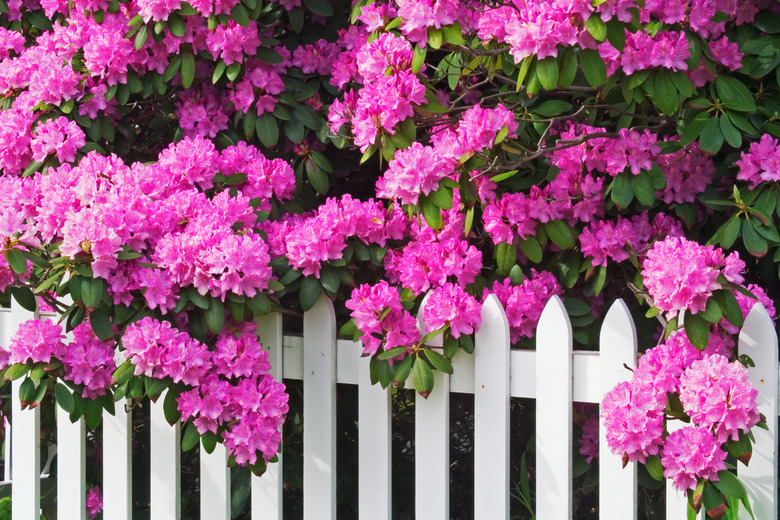How To Revive A Distressed Rhododendron
We may receive a commission on purchases made from links.
Signs of rhododendron distress can usually be traced to incorrect culture or plant location. Determining the underlying problem with your flowering shrub is necessary to restore the rhododendron's health. Leaves are the best indicators of plant problems. Wilting, browning at the edges, brown spots in the center of the leaf, or very dark green veins are all signs of different problems.
Troubleshoot your rhododendron by taking a small cutting to a local Master Gardener for a diagnosis. Bring a section of leaves and a soil sample if possible. Reviving a distressed rhododendron may require a combination of remedies if there is more than one stress factor involved. You can try some simple diagnoses and remedies that will often cure the problem.
Things Needed
Distress Causing Bloom Failure
1. Assess the Age
Consider the plant's age. Young rhododendrons have to form a framework of branches before they flower. Some species may require five years to bloom. If your rhododendron is young and hasn't bloomed at all, it might need more time.
2. Consider the Site
Check the area where you planted the rhododendron. Heavy shade causes a lack of blooms. Sun recommendations can vary by variety, but all types need some sun to bloom. Cut back overhanging plants as needed to provide more sunlight. Transplant the rhododendron if necessary.
3. Reduce Fertilizer
Cut back on high-nitrogen fertilizer because too much causes shoot growth, not bloom.
4. Deadhead the Flowers
Deadhead rhododendrons continuously during the spring to prevent seed set. Producing seeds lowers the plant's production of flower buds.
5. Protect Against Cold
Protect your rhododendron from freeze-thaw cycles in the winter. Create a burlap screen for the rhododendron in extreme climates. For milder climates maintain a good layer of mulch and make sure not to plant it in openly windy areas or low spots.
6. Prune Properly
Follow proper pruning recommendations for rhododendrons. Pruning improperly will prevent flowering and can cause die-back to bare wood in some varieties. Check a good gardening book to find the difference between flower buds and terminal leaf buds and prune according to a pruning guide for your variety.
Distress Manifested by Chlorosis
1. Inspect the Leaves
Diagnose by checking the leaves, which will be very pale or yellow with dark green veins. Determine the cause by analyzing your soil and your cultural practices.
2. Plant It Higher
Lift the rhododendron and reset it higher up in its planting bed if necessary. Planting too deeply prevents the roots from functioning to take up nutrients.
3. Minimize Cultivation
Limit cultivation near the shrub as destroying shallow roots with cultivation may be the cause.
4. Watch Watering and Fertilizing
Stop overwatering and overfertilizing your rhododendron. Check a good gardening manual for your variety and follow the care recommendations.
5. Test the Soil
Test your soil for lack of iron or magnesium. Treat lack of iron with a foliage spray of chelated iron according to the manufacturer's directions. Spray your rhododendron with 2 tablespoons of Epsom salts in 1 gallon of water if it's suffering from a lack of magnesium.
Sunburn, Windburn, and Salt Distress
1. Check for Brown Patches
Inspect the leaf's center. Finding round brown patches near the leaf center or along the edges can be a sign of sunburn. Water your rhododendron for a longer time and more often. Shade the plant with a reed screen or change its location.
2. Look at the Edges
Look at the leaf edges. Browned edges on new growth usually mean windburn. Protect your rhododendron with a reed screen until you can move it to a less exposed location. Plant a windbreak of taller shrubs like thuja pyramidalis around your rhododendron.
3. Check the Tips
Check the leaf tips for issues. Browning of tips and brittle browning of margins indicates salts injury. Test your soil for alkalinity and drainage or have it tested by your local university extension office. Lift the rhododendron and enlarge the planting hole to three times the size and depth of the root ball. Add soil amendments recommended to improve drainage and correct the pH as needed.
Other Environmental Issues
1. Check for Frost Damage
Protect tender plants by erecting a burlap screen and filling it loosely with straw after the ground has frozen. This can prevent distortion and death of the leaves from frost. If your rhododendron is injured every year, move it to a new location in early March.
2. Protect Splits
Prevent additional problems with bark that splits. Splitting bark is a dangerous problem and rhododendrons distressed this way may die back. Paint splits with a grafting compound or tree wound sealer.
3. Help Drooping Leaves
Correct drooping leaves by spraying foliage with water in the early evening.
4. Improve Drainage
Check your soil drainage. If water runoff is too fast, add soil amendments and water longer and more deeply.
5. Add Mulch
Mulch the root zone out to the drip line to maintain moisture. With proper mulching, your rhododendron can grow better.
